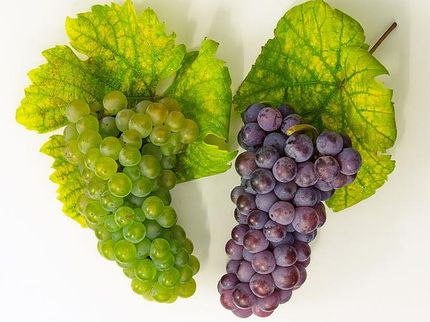Red Riesling originated from White Riesling – not vice versa
Berry color locus of the Red Riesling variant located on the chromosome set of the white-berried parent White Heunisch
Advertisement
The ancestors of today's cultivated grapevine varieties as well as almost all wild Vitis species have dark berries at the time of ripening. For a long time, breeders and scientists therefore assumed that the white-berried grapevine variety 'White Riesling' (RW), commonly referred to as 'Riesling', must have evolved from its red-berried twin 'Red Riesling'(RR). A study from the JKI Institute for Grapevine Breeding now refutes what experts expected to be true: "In the past, it was believed that the 'Red Riesling' represents the original grapevine variety. Especially since spontaneous mutations from red to white berries were observed again and again, but never vice versa," says Dr. Franco Röckel of the Julius Kühn Institute in Siebeldingen. "The examination of the chromosome sets (haplophases) of the 'Red Riesling` genome finally gave us certainty: the haplophase that leads to color in the red variety comes from the white-berried parent. Consequently, the mutation "red" must have happened in the 'White Riesling'".

Lured the experts onto the wrong track at first: the spontaneous reversion of the Red Riesling to partially white grapes.
JKI/Röckel
The parents of the Riesling vine are the bright colored 'White Heunisch' and probably a seedling of 'Traminer' and V. sylvestris with unknown berry- color. Therefore, the red color could theoretically have had its roots in the unknown parent. The scientists at the Geilweilerhof site in Siebeldingen first investigated two genes (VvmybA1 and VvmybA2) known to regulate the coloration of dark berries. In white grapevine varieties, these gene segments are altered (mutated) and do consequently not form color pigments (mainly anthocyanin) in the berries at the beginning of ripening. However, the results of the PCR tests and sequencing of the 'Red Riesling' were surprising: neither of the two known genes VvmybA1 and VvmybA2 was responsible for the red color of the grapes.
In order to narrow down the unknown gene locus, Dr. Franco Röckel used self-fertilization to produce RW and RR seedlings (clones) whose color expression is identically coded on both chromosomes (homozygous alleles). Subsequent PCR tests then revealed a new product, which turned out to be a previously unknown VvmybA gene variant (VvmybA3/1RR). This gene variant is also capable of initiating color formation at berry ripening.
To clarify from which parent the mutated haplophase originates, the JKI scientist analyzed the homozygous RR progeny using SSR markers (so-called microsatellites). These characteristic gene sequences can in turn - like a genetic fingerprint - clearly be assigned to the RW parent 'White Heunisch'. According to this, VvmybA3/1RR must be the result from a mutation in 'White Riesling', since no comparable red color mutant has been described for Heunisch.
All of the approximately 17 'Riesling Red' clones examined in this study have the same mutation. The JKI researchers assume that the mutation in RR is stably conserved in the genome, underlined by the fact that no spontaneous mutation from white to red has been observed so far. However, the exact cause why 'Red Riesling' occasionally mutates back to white remains unexplained.





























































